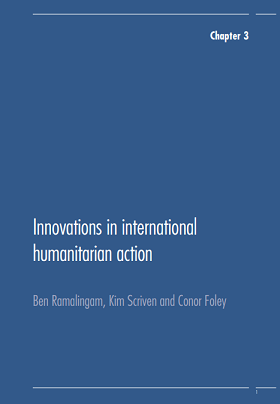Innovations in International Humanitarian Action
This document forms the third chapter of ALNAP’s 8th Review of Humanitarian Action, for more information and access to other chapters, please click here.
Critics of humanitarian aid, many from within the sector, complain that humanitarian evaluations and other learning exercises repeatedly highlight the same problems and shortcomings, and ‘tell us nothing new’. The fact that evaluations don’t capture novelty and ideas does not mean that the humanitarian endeavour is lacking an innovative spirit. The motivation to extend assistance to those affected by conflict or natural calamity has driven individuals to extreme lengths – and led to considerable ingenuity and perseverance.
The starting point of this ALNAP study is that much ongoing work in the realm of humanitarian learning and accountability does not seek to generate new and different ways of operating. Rather, it focuses on existing practices, policies and norms of behaviour, and involves detecting and correcting deviations and variances from these standards, or finding ways in which standard operating procedure can be better implemented. The focus is on incremental improvements in practices. Much humanitarian learning arguably focuses on single-loop learning at individual and group levels – hence the frequent ‘nothing new’ criticism.
Questioning existing practices, norms, policies and rationales can often lead to direct conflict with ongoing organisational processes. Such ‘generative learning’ is also inhibited by a growing culture of compliance and the rigid contractual nature of aid relationships, both of which push agencies to deliver according to pre-defined goals, methods and targets.
In response to this, and the perceptions of continued learning failures, there are growing numbers of thinkers and practitioners within the sector who argue that agencies need to start pushing the boundaries of current humanitarian practice. If established aid organisations fail to prioritise innovations, they are in danger of losing popular support and being overtaken by new types of relief organisations.
This study aims to explore how ALNAP members and the wider sector might prioritise innovation and risk-taking in policy and practice. It does so by first reviewing experience in the private, public and third sectors to develop a conceptual model which should enable a better understanding of what innovations mean for the sector. It goes on to explore this model using evidence from five case studies, key informant interviews and desk research, and in conclusion recommends ways to promote and enable positive innovation in humanitarian action.



